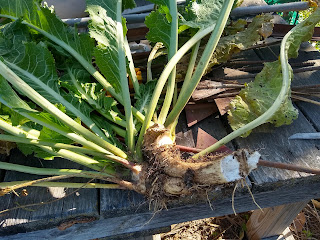 |
Here's another 'Aisle 6' that needs major attention. The tomatoes on the tarp garden just out did themselves this year. I've got a ton of tomato juice/sauce/paste to show for it, too. But.... |
 |
These ones are Centennials. They're OK, but they get long and leggy. That other stuff around them is what frostbit sweet potato vines look like after a very sudden 16F we had overnight recently. |
 |
I do have some nice spuds for winter though. There's nothing like home grown veggies. |
How to clean them? Make a machine for it, of course! Here is a little video of my 'Cement Mixer - Spud Washer' in action. I had left over rubber chicken plucker fingers from when I built my Whizbang Chicken plucker. I made a belt out of an old plastic drum with the fingers in it. I can put this inside a cement mixer, add water and potatoes, and let 'er rip! Works a charm, as they say.
 |
Annie just knew there were mice or something good down there. |
 |
The deeper she got, the more committed she was to the project. I want to move it anyway, so I let her do the heavy work for me. She and I were both pleased! |
 |
It takes several passes back and forth. It ain't a perfect science. |
 |
I use a screen to help get the filtering done near the end. |



































